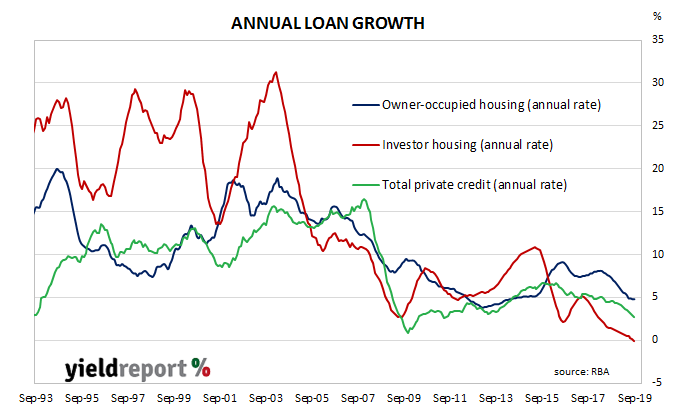The pace of lending to the non-bank private sector by financial institutions in Australia has been trending down since October 2015. It appeared to have stabilised in the September quarter of 2018 but then subsequent credit figures put paid to that idea. Despite some optimism emerging in the housing market following the re-election of the Coalition Government in May, lending figures have continued to slow.
According to the latest RBA figures, private sector credit grew by 0.2% in September, in line with the expected figure and the same as August’s number. The annual growth rate continued its downward slide as, this time from August’s figure of 2.9% to 2.7% in September. Lending to business picked up a little but the owner-occupier segment remained subdued and investor lending moved into negative territory.
Westpac senior economist Andrew Hanlon said, “Housing finance is rising but housing credit growth has yet to stir, held back by the investor segment.” Local bond yields ignored largish falls of US Treasury yields in overnight trading and yields at the short end moved a little higher, although the latest home approvals report would have had some effect as well. By the end of the day, 3-year ACGB yields had gained 3bps to 0.81% while the 10-year yield remained unchanged at 1.14% and the 20-year yield had crept up 1bp to 1.54%.
Local bond yields ignored largish falls of US Treasury yields in overnight trading and yields at the short end moved a little higher, although the latest home approvals report would have had some effect as well. By the end of the day, 3-year ACGB yields had gained 3bps to 0.81% while the 10-year yield remained unchanged at 1.14% and the 20-year yield had crept up 1bp to 1.54%.
Prices of cash futures contracts moved to dampen expectations of another cut in the cash rate. By the end of the day, November contracts implied just a 5% chance of another 25bps rate cut, down from the previous day’s 7%. December contracts implied a 24% chance of a cut, down from 35% while February contracts implied another cut as a 49% likelihood, down from the previous day’s 65%.

